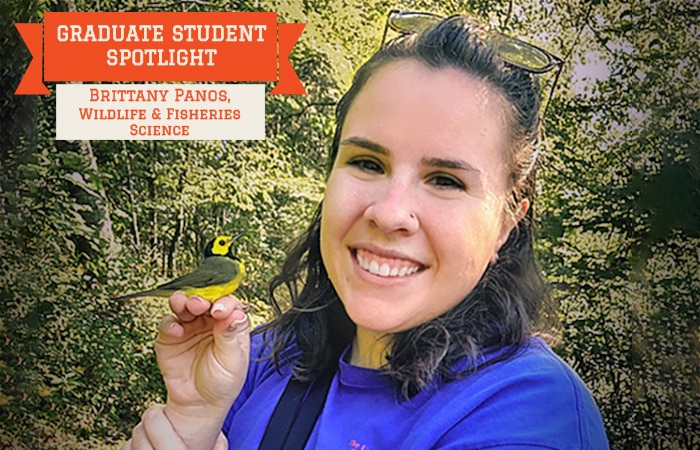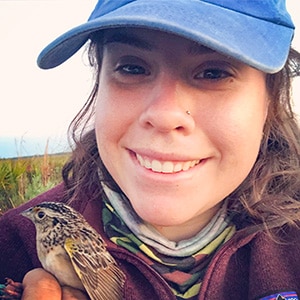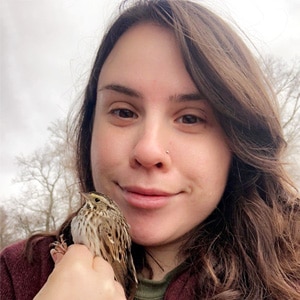
Panos holding a male Hooded Warbler
Agriculture and conservation have been on a collision course for generations. Farming provides critical food resources and revenue in agrarian states like Tennessee, but the environmental impacts of some farming methods can be devastating. From increased run-off and habitat loss, to chemical pollution and greenhouse gas emissions. Brittany Panos hopes to provide support for efforts that make farming more environmentally sustainable through the intersection of agriculture and bird conservation.
Panos’s research is the continuation of her life-long interest in birds, cultivated by her grandfather. “My abuelo was from Cuba where there is amazing bird biodiversity and they have so many incredible bird species; he was always teaching me about birds,” Panos said. “He passed that fascination on to me and that started me on the path to studying birds.”

Panos holding a critically endangered Florida Grasshopper Sparrow
Panos studies the potential impact of cover crops on migratory bird populations. Cover crops are a type of herbaceous planting grown during the wintering season between cash crops like corn, soybeans, and cotton. This agricultural practice benefits farmers by enriching the soil and minimizing erosion, but it also positively impacts the environment through improved soil and water quality and reduced need for chemical fertilizers and herbicides.
In recent years, the federal government has developed several programs that encourage landowners to incorporate more sustainable practices into their farming strategy. One program—the Natural Resource Conservation Service (NRCS)—provides financial incentives and technical assistance for farmers to use cover crops. Panos partners with landowners that currently participate in NRCS programs and conducts her research on their property.
The potential impact of cover crops on wildlife is an emerging research topic in agriculture. “How cover crops impact wildlife, specifically birds, is not well known,” Panos said. “I am specifically looking at how birds are using these cover crop fields, versus fields that have no cover crops planted, during the wintering, migration, and nesting periods.”

Panos holding a Savannah Sparrow
If cover crops could provide beneficial habitat for migrating birds, they could help slow the decline of bird populations that has been happening over the last 50 years. Recent studies estimate that the western hemisphere may have lost as many as one in four birds in the past 50 years. Birds provide a variety of ecosystem services such as pest control and seed dispersal, therefore, their decline could negatively impact food webs and ecosystems around the globe.
Although Panos is conducting her research in Tennessee, the results could have far-reaching impacts. “Tennessee plays a huge role in bird conservation because the state is on one of the largest migratory pathways for birds,” Panos said. “Hundreds of species of birds rely on suitable habitat during their seasonal migrations, which can be as far as Central and South America into Canada.”
By researching the impacts of cover crops on migratory birds, Panos hopes to provide additional support for the practice of using cover crops. Currently, not all farmers in Tennessee are participating in NRCS incentive programs. Panos hopes her research will continue to bridge the gap between agriculture and conservation by encouraging more landowners to participate.
“Bird populations in North America are declining, especially grassland species, primarily due to habitat loss because so many grassland communities have been converted into agricultural landscapes,” Panos said. “If I can demonstrate that cover crops can be beneficial for displaced grassland and migratory bird species, then perhaps more farmers will begin to implement the practice not only for biophysical reasons, but for conservation management as well.”